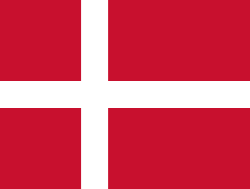Flag of Denmark

The flag of Denmark, called the Dannebrog by the Danes ( Danish: Dannebrog; Dannebrog) is a red rectangular cloth depicting a white Scandinavian cross - a straight cross, the vertical cross of which is shifted to the pole edge of the cloth. In 1748, King Frederick V set the size of the flag at a ratio of 14:17, the modern ratio (in force since 1926) was 28:37.
The Dannebrog is the oldest active state flag, the documented history of which goes back to the XIV century.
Legend of the Appearance
The Dannebrog descends to earth during the Battle of Lindanis on June 15, 1219. Artist Christian August Laurentsen, 1809. The original is in the State Museum of Art, Denmark
In 1219, under the pretext of Christianization and with the blessing of the Pope, the army of the Danish king Valdemar II, later called the Victor, landed near Kolyvani (Danish: Kolyvani). Lyndanisse) and, having captured the hillfort, it was located near the hill (modern. Toompea).
On June 15, 1219, detachments of Estonians attacked the Danish army led by the king and bishops. This attack was so unexpected that part of the Danish detachments began to retreat. Then the bishops climbed the hill and cried out to God for help. Suddenly, a large red cloth with a straight white cross fell from heaven. Confident in God's sign, the Danes perked up and defeated the Gentiles.
Victory Day at the Battle of Kolyvan, also known as the Battle of Valdemar, came to be celebrated as Dannebrog's birthday.
Every summer in the Danish King's Garden in Tallinn there is a holiday in honor of Dannebrog, which is a great success with tourists from Denmark. According to legend, an iron knight in the garden points to the place where the flag dropped to the ground.
Other theories about the origin of the flag
Perhaps the model for Dannebrog was the flag of the Holy Roman Empire of the XIII-XIV centuries.
- Arts
- Business
- Computers
- Juegos
- Health
- Home
- Kids and Teens
- Money
- News
- Recreation
- Reference
- Regional
- Science
- Shopping
- Society
- Sports
- Бизнес
- Деньги
- Дом
- Досуг
- Здоровье
- Игры
- Искусство
- Источники информации
- Компьютеры
- Наука
- Новости и СМИ
- Общество
- Покупки
- Спорт
- Страны и регионы
- World


